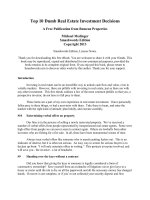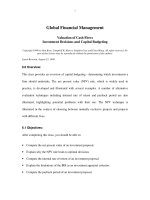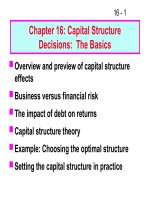Capital investment decisions
Bạn đang xem bản rút gọn của tài liệu. Xem và tải ngay bản đầy đủ của tài liệu tại đây (635.37 KB, 27 trang )
Capital
Capital Investment
Investment
Decisions
Decisions
Session
Session Summary
Summary (1)
(1)
learning objectives
what is an investment
the five main investment appraisal criteria methods
accounting rate of return (ARR)
payback
key principles underlying investment selection criteria
Session
Session Summary
Summary (2)
(2)
discounted payback
future values of £100 using a discount rate of
5% per annum
discounted cash flow (DCF)
net present value (NPV)
internal rate of return (IRR)
interpolation of the internal rate of return (IRR)
extrapolation of the internal rate of return (IRR)
Session
Session Summary
Summary (3)
(3)
advantages and disadvantages of the five investment
appraisal methods
other factors affecting investment decisions
risk and uncertainty and decision-making – sensitivity
analysis
project appraisal factors used in sensitivity analysis
control of capital investment projects
Learning
Learning Objectives
Objectives (1)
(1)
explain what is meant by an investment
outline the key principles underlying investment
selection criteria
outline the strengths and weaknesses of the five
investment appraisal criteria
explain what is meant by discounted cash flow (DCF)
consider investment selection using the appraisal
criteria of net present value (NPV) and internal rate
of return (IRR)
Learning
Learning Objectives
Objectives (2)
(2)
explain the effects of inflation, working capital
requirements, length and timing of projects, taxation, and
risk and uncertainty on investment criteria calculations
evaluate the impact of risk and the use of sensitivity
analysis in decision-making
consider the ways in which capital projects may be
controlled and reviewed
appreciate the importance of the project post-completion
audit
What
What is
is an
an Investment?
Investment?
an investment requires expenditure on something today
that is expected to provide a benefit in the future
the decision to make an investment is extremely important
because it implies
the expectation that expenditure today will
generate future cash gains
in real terms
that greatly exceed the funds spent today
The
The Five
Five Main
Main Investment
Investment
Appraisal
Appraisal Criteria
Criteria Methods
Methods
Accounting
Accounting Rate
Rate of
of Return
Return
(ARR)
(ARR)
ARR = average accounting profit over the project x 100%
initial investment
Payback
Payback
the number of years it takes the cash inflows from a
capital investment project to equal the cash outflows
Key
Key Principles
Principles Underlying
Underlying
Investment
Investment Selection
Selection Criteria
Criteria
(1)
(1)
CASH IS KING
real funds flows can be seen in cash but not in accounting
profit
interest charges become payable as soon as money is
made available, for example, from a lender to a borrower,
not when an agreement is made or a contract is signed
Key
Key Principles
Principles Underlying
Underlying
Investment
Investment Selection
Selection Criteria
Criteria
(2)
(2)
TIME VALUE OF MONEY
receipt of £100 today has greater value than receipt of
£100 in one years time
there are two reasons for this
Key
Key Principles
Principles Underlying
Underlying
Investment
Investment Selection
Selection Criteria
Criteria
(3)
(3)
reason 1
money could have been alternatively invested in say riskfree Government gilt-edged securities
the actual rate of interest that will have to be paid
will be higher than the Government rate, to
include a risk premium - neither companies nor
individuals are risk-free borrowers
Key
Key Principles
Principles Underlying
Underlying
Investment
Investment Selection
Selection Criteria
Criteria
(4)
(4)
reason 2
purchasing power will have been lost over a year due to
inflation
generally, the higher the risk of the investment, the
higher the return the investor will expect from it
Future
Future Values
Values of
of £100
£100 using
using aa
Discount
Discount Rate
Rate of
of 5%
5% Per
Per
Annum
Annum
Discounted
Discounted Cash
Cash Flow
Flow (DCF)
(DCF)
the principles underlying the investment appraisal
techniques that use the DCF method are cash flow
(as opposed to profit), and the time value of money
of the five main criteria used to appraise investments,
net present value (NPV), internal rate of return (IRR),
and discounted payback are discounted cash flow (DCF)
techniques
the technique of discounted cash flow discounts the
projected net cash flows of a capital project to ascertain
its present value, using an appropriate discount rate, or
cost of capital
Net
Net Present
Present Value
Value (NPV)
(NPV)
NPV is today’s value of the difference between cash
inflows and outflows projected at future dates,
attributable to capital investments or long-term projects
Internal
Internal Rate
Rate of
of Return
Return (IRR)
(IRR)
the IRR calculates the exact rate of return that a project
is expected to achieve, which is the discount rate used
that results in a zero net present value (NPV) of the
difference between cash inflows and outflows
Interpolation
Interpolation of
of the
the
Internal
Internal Rate
Rate of
of Return
Return (IRR)
(IRR)
Extrapolation
Extrapolation of
of the
the
Internal
Internal Rate
Rate of
of Return
Return (IRR)
(IRR)
Discounted
Discounted Payback
Payback
the discounted payback method requires a discount rate
to be chosen to calculate the present values of cash flows
and then the payback is the number of years required to
repay the original investment
Advantages
Advantages and
and Disadvantages
Disadvantages of
of the
the
Five
Five Investment
Investment Appraisal
Appraisal Methods
Methods
Other
Other Factors
Factors Affecting
Affecting
Investment
Investment Decisions
Decisions
Additional factors impacting on investment criteria
calculations are:
the effect of inflation on the cost of capital
working capital requirements
length of project
taxation
risk and uncertainty
Risk
Risk and
and Uncertainty
Uncertainty and
and
Decision-Making
Decision-Making
–– Sensitivity
Sensitivity Analysis
Analysis (1)
(1)
There may be a number of risks associated with each of
the variables included in a capital investment appraisal
decision:
estimates of initial costs
uncertainty about the timing and values of future cash
revenues and costs
the length of project
variations in the discount rate
Risk
Risk and
and Uncertainty
Uncertainty and
and
Decision-Making
Decision-Making
–– Sensitivity
Sensitivity Analysis
Analysis (2)
(2)
sensitivity analysis may be used to assess the risk
associated with a capital investment project









